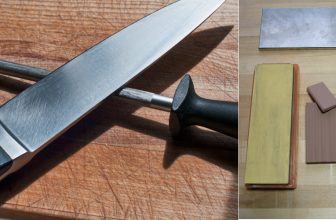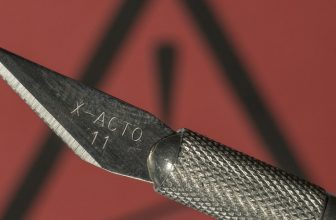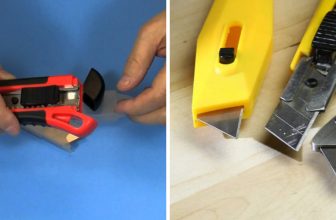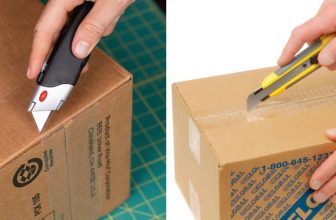How to Sharpen Tanto Blade
A tanto blade is a type of knife that has a short and wide blade. The tanto blade shape makes the knife very strong and withstands much pressure. However, the tanto blade can become dull over time and need to be sharpened.
That’s why it’s essential to know how to sharpen your knives regularly, so they’re always sharp and ready for use. This blog post will show you how to sharpen a tanto blade using a whetstone. We will also provide tips for maintaining your tanto blade’s sharpness over time. So let’s get started!
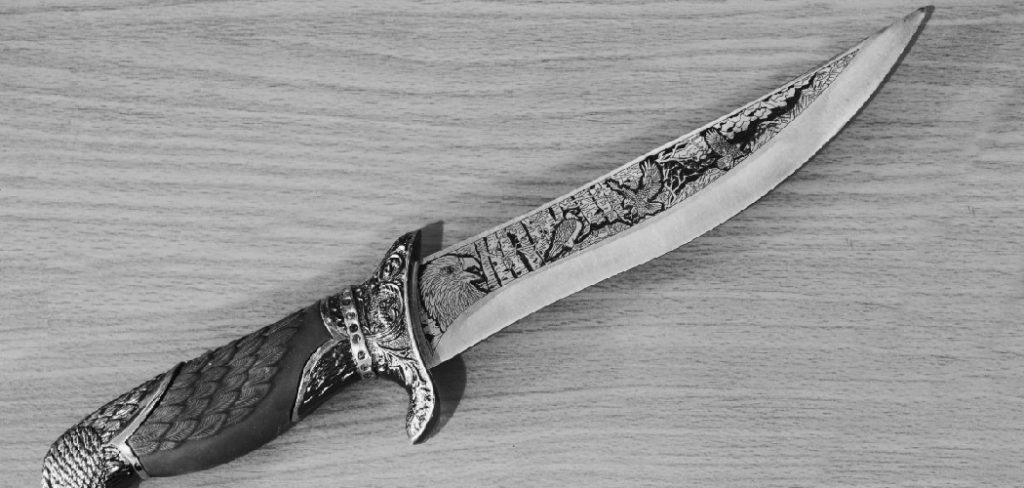
What Is A Tanto Blade?
A knife with a tanto point blade is one of the most distinctive blades in the cutlery industry. Its features are its chisel-pointed blade with two sharp edges, instead of just one. In addition, the back edge of the tanto knife runs straight from the handle and stops at the tip, which gives it an extremely sturdy point that’s also very strong.
The reasons tanto knives are particularly popular with collectors are many. It is believed that tanto knives originated in Japan and were used as blades for tantojutsu, or knife fighting. The unique design of the tanto blade makes it strong and versatile, two important qualities for any knife. Whether you’re a collector or simply someone who appreciates a good knife, a tanto is definitely worth considering.
8 Benefits of Using A Tanto Blade:
1. They can penetrate the body using a thrusting motion more readily than any other design of knife blade.
2. They hold their edge well and cannot be as easily dulled as many other styles of knives.
3. It’s easier to defend against a tanto-style blade due to its straight-edged design, making it easy to slash and cut.
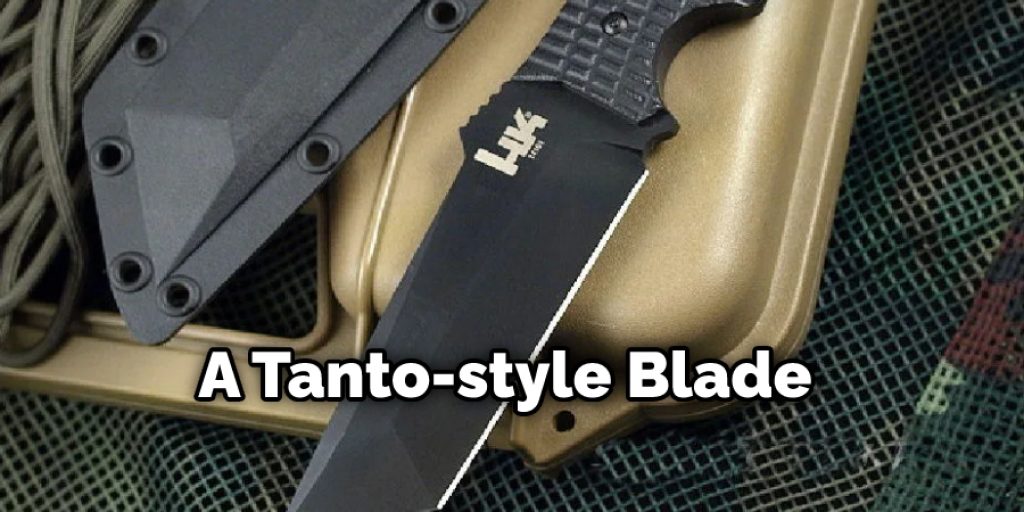
4. The straight edge is easy to keep sharp.
5. This knife is good for stabbing because it is sharp and can go through things easily.
6. The point is stronger than the typical blade tip and less likely to break or bend.
7. The lock-back design eliminates exposure to the locking mechanism, which can be dangerous when working with other knives that utilize a liner lock system.
8. A tanto-style blade is usually made of an alloy that provides increased strength in the tip region.
Procedure: How to Sharpen Tanto Blade
Step 1: Find the Right Sharpening Stone.
One of the most important aspects of learning how to sharpen a knife is finding the right sharpening stone. For beginners, there are six types of stones to choose from: whetstones (coarse), an intermediate diamond stone, an advanced synthetic stone, ceramic, carbide, and natural stones.
Step 2: Select the Right Angle.
When picking a tanto blade knife, you always need to make sure it’s sharp. But if you want the tanto to be extra sharp, choose a different angle between 15 and 20 degrees. Measure this with your protractor or another instrument that measures angles.
Step 3: Sharpen Your Knife.
Once you have found the right sharpening stone and determined the ideal angle, then you only need to apply a moderate amount of pressure as you move the blade back and forth.
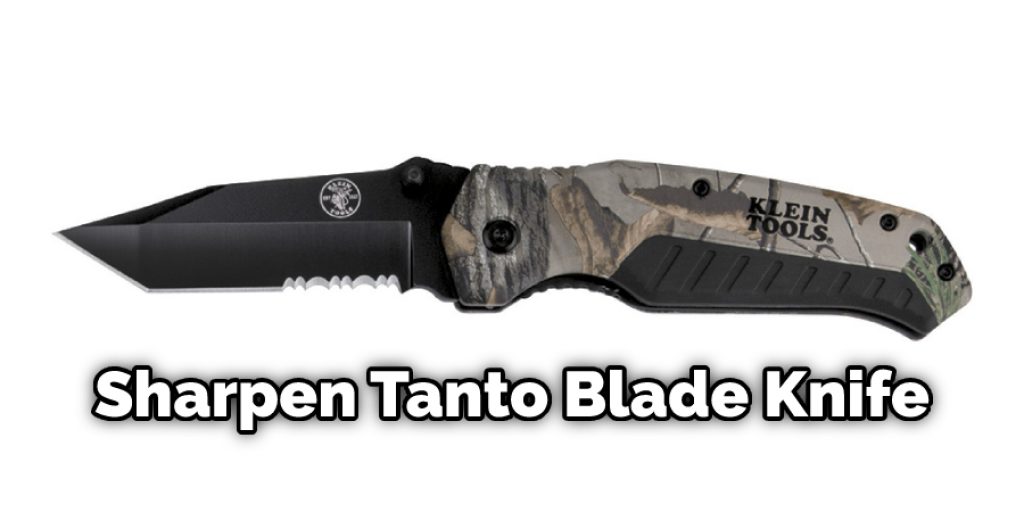
Step 4: Stroke Length.
For those new to sharpening knives, it is best to use a 5-6 inch range for stroke length. If you want to make your tanto knife razor-sharp, then speed up the process by applying more pressure as you move the knife farther away from you. Continue this until you have sharpened your entire blade.
Step 5: Add a Polishing Touch.
If you want to make sure that your tanto knife is as sharp as possible, then use some polishing compound after you are done with the sharpening stone. This will give your blade a mirror-smooth finish.
Step 6: Work on the Handle.
Sharpening your tanto blade should be easy, but you may have to work on the handle to make sure it’s smooth. The simplest way is to use sandpaper between 1,000 and 2,000 grit. If there are any grooves or patterns, use a finer grit to smooth them out.
Step 7: Add Some Oil.
If you want your tanto blade to stay sharp longer, add some mineral oil when you are finished with the steps above. Mineral oil can be found at any grocery store and tends to be cheaper than most other oils.

Step 8: Examine Your Knife.
If you are not satisfied with how sharp your tanto is after using this method, sharpen it again until you are satisfied. You may also want to try finding a different sharpening method if the process above is too difficult for you.
Some Helpful Tips and Suggestions
Here are some tips and suggestions on how to sharpen the tanto blade.
1. Make sure you have enough light to see clearly
2. Put the blade on something solid so that it won’t move around
3. Make sure there is no water near your workspace (this will reduce chances of rusting and corrosion)
4. Put the blade on a towel so if your blade does slip, it won’t be as sharp of an injury
5. Make sure you have something to catch the metal filings (they will come off as you sharpen)
6. Make sure the blade is not very sharp before starting, so you don’t cut yourself. If it is very sharp, or if it has been recently sharpened by someone else, the metal could be more brittle and easier to chip.
7. Make sure there’s a liquid release agent on any stone you might use.
How To Properly Sharpen A Pocket Knife?
Pocket knives are extremely handy to have, but after a while, the blades get dull and require sharpening. Pocket knives have a blade that folds into the handle. A sharpener can be used to restore the blade’s cutting edge by grinding away the blade’s metal that has become dull with use. Grinding is done using a sharpening stone and moving the blade in a circular motion while applying pressure.
Once the blade is sharp, a honing tool can be used to make slight adjustments. Sharpening and honing should be done before beginning to cut as it results in a better finish. Pocket knives are used to open boxes of envelopes and do various other jobs. A sharp knife should cut through paper easily while still pressing down on the blade without splitting the paper.
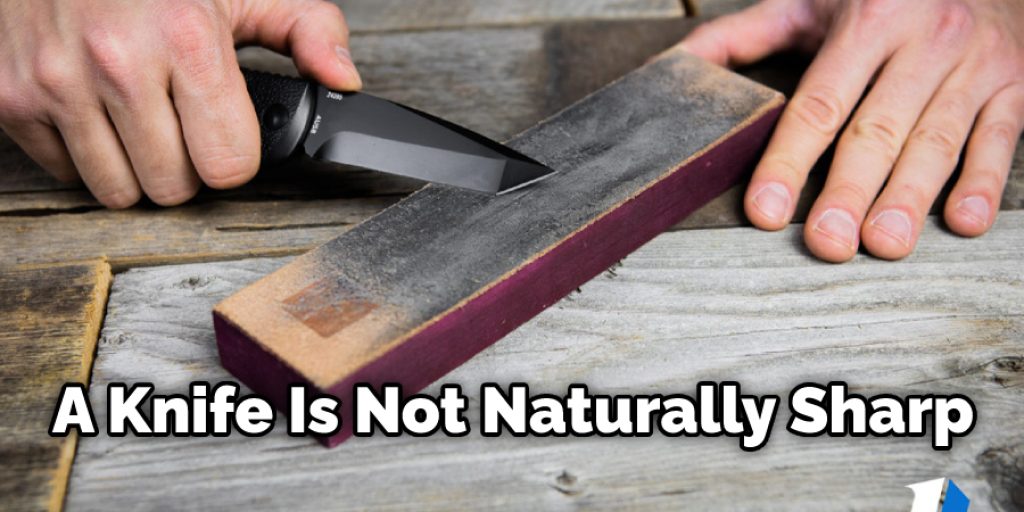
What Makes The Sharpest Knife?
A knife is not naturally sharp, and it is typically made sharp. Therefore, people who use knives need to make sure they use the sharpest blades. Having a working blade dulls quickly for most people due to the frequency of use and modern cutting tasks like slicing vegetables or meats. A dull edge can cause more damage than good when cutting something, so it’s important to maintain the edge.
A knife edge is made from a specific angle on both sides of the blade. This forms a “V” shaped wedge, which allows for cutting through materials easily and without much pressure applied to the blade by the user. People have been using various methods over time to maintain this sharp edge.
The most common way is sharpening stones, made of multiple levels. The stones must be abrasive enough to take off material, but not too much. They are typically laid out in order from the coarsest to smallest within various grits, which is essentially how rough or fine they are to work with.
Is There Any Special Technique to Use When Sharpening a Tanto Blade?
Tanto blades are generally double-edged with a very pointy tip. You can sharpen this type of blade as you would any other, but the tip calls for special attention. The first step is to identify the bevel angle on each side of the tanto’s tip. Sometimes there will only be one bevel angle; other times, there will be two. The second step is determining which bevel angle or angles you need to sharpen for your desired blade sharpness.
Once the proper bevel angle has been identified, sharpen each side of the blade with a whetstone and lubricant (if needed). Sharpening should always be done in several passes with the blade angle held steady throughout.
How to Tell if My Blade Needs Sharpening?
If your tanto knife is not cutting materials cleanly or feels like the blade has lost its edge, it’s time for maintenance. Some ways to tell if your tanto needs sharpening are: Your blade isn’t sharp enough to cut through paper, wood, or shaving hair. Also, your blade has dents and chips that damage the edge.
The first step for tanto knife sharpening is it should be kept dry as possible before you start the process. This will ensure that there isn’t any rust on your blade, making the sharpening process difficult and essentially rendering the blade useless.
Conclusion
Although the tanto blade has a sharper edge, it is also more brittle than other blades. For this reason, you should avoid using the tanto blade for hard-cutting tasks. Instead, use the tanto blade for precision slicing and piercing tasks. The tanto blade can provide you with many years of sharp-cutting performance when cared for properly.
Although the tanto blade is not as popular as other blades, it has its advantages. With a little bit of practice and some tips from this article on how to sharpen the tanto blade, you should be able to sharpen your tanto blade like a pro in no time. So what are you waiting for? If you have any questions, please feel free to comment below!

